November 25, 2024 · 13 min read
Improving Transparency in Government Committees Using AI Documentation

Shaimaa Badawi
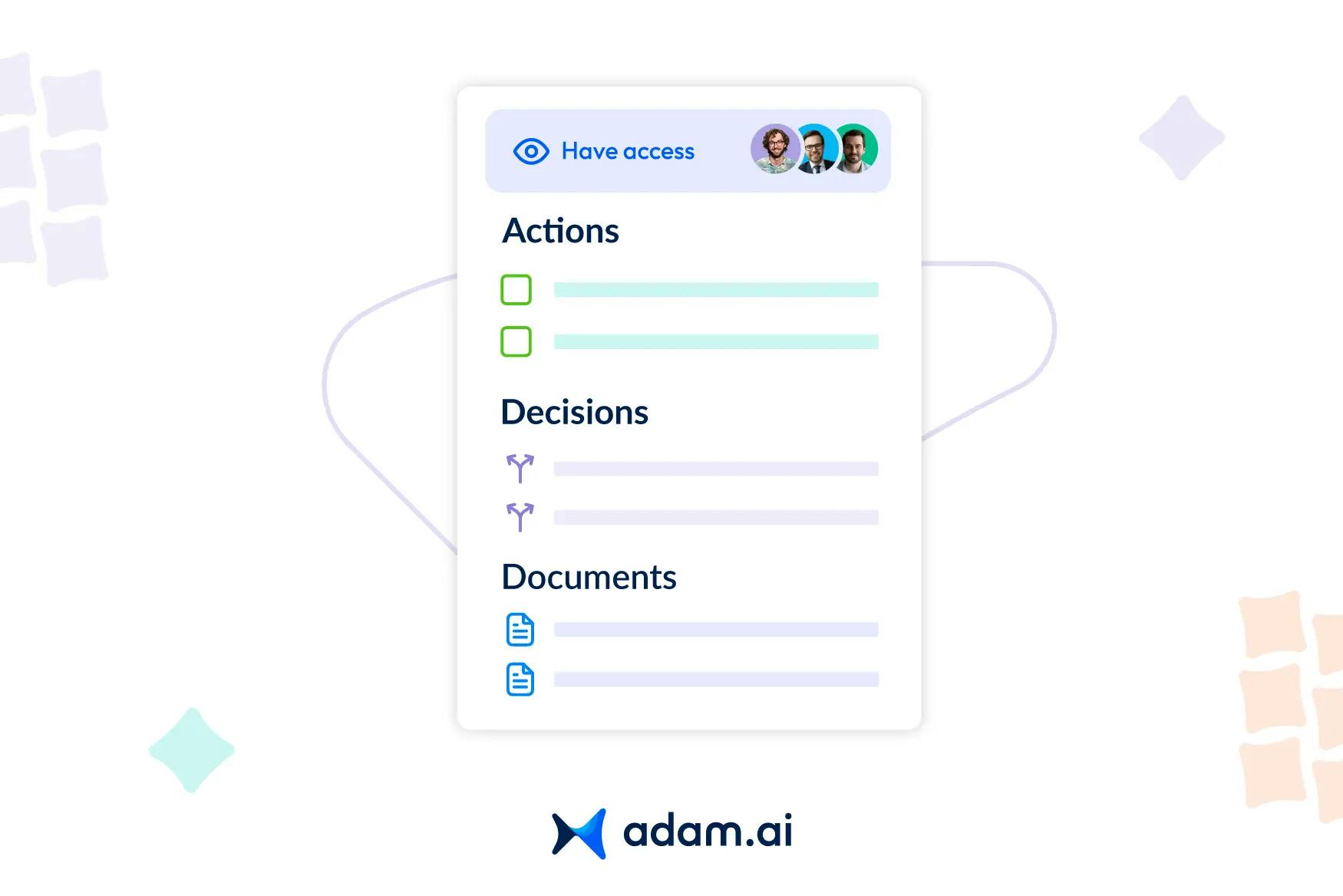
Transparency is the foundation of trust in government committees, yet achieving it often comes with challenges like disorganized documentation, miscommunication, and lack of accountability. With the rise of AI-driven tools, these obstacles are being addressed through smarter, automated documentation processes. This article explores how AI documentation enhances transparency at all levels of government, from local councils to federal agencies, offering global examples, best practices, and actionable insights.
Why is transparency crucial for the success of government committees?
Transparency is the cornerstone of effective governance and plays a vital role in the success of government committees. By ensuring that processes, decisions, and actions are visible and accessible to stakeholders, transparency builds trust, fosters accountability, and promotes efficiency. Here’s why it matters:
1. Builds public trust
Transparent operations reassure citizens that government committees are working in their best interests. When the public has access to information about deliberations and decisions, it enhances confidence in governance and reduces skepticism about hidden agendas or corruption.
2. Promotes accountability
When committee activities are open to scrutiny, members are more likely to adhere to ethical standards and fulfill their responsibilities. Transparency ensures that decisions can be traced back to their source, holding members accountable for their actions.
3. Encourages inclusive participation
Transparency allows all stakeholders, citizens, interest groups, and other government bodies, to stay informed and contribute meaningfully. This inclusivity strengthens policy outcomes by incorporating diverse perspectives.
4. Reduces miscommunication
Clear and accessible documentation of decisions and processes minimizes misunderstandings among committee members and stakeholders. Transparency ensures that everyone operates with the same information, reducing conflicts and inefficiencies.
5. Enhances decision-making
With transparent systems in place, committees can make decisions based on well-documented evidence and inputs. This clarity leads to more informed, fair, and effective outcomes.
What are the current challenges in achieving transparency in government committees?
Despite the critical role of transparency in government committees, several challenges often hinder its achievement. These obstacles can arise from organizational inefficiencies, technological limitations, or resistance to change. Here are the key challenges:
1. Lack of standardized processes
Many committees operate without uniform guidelines for documenting decisions, tracking actions, or sharing information. This inconsistency creates gaps in transparency and leaves stakeholders uncertain about the processes being followed.
2. Resistance to change
Implementing transparency measures often requires a cultural shift within committees. Resistance from members who are accustomed to traditional ways of working can slow the adoption of more open and accountable practices.
3. Technological limitations
Outdated systems and the lack of digital tools make it difficult to maintain and share accurate records. Without technology to streamline operations, documentation and communication become prone to errors or delays.
4. Confidentiality concerns
Government committees often deal with sensitive information that cannot always be shared publicly. Striking the right balance between transparency and confidentiality remains a significant challenge.
5. Lack of public engagement
Transparency is undermined when committees fail to engage the public effectively. Limited access to information or overly complex communication channels can discourage citizens from participating or monitoring committee activities.
6. Resource constraints
Committees may lack the resources, time, personnel, or funding, to implement transparency initiatives effectively. This can lead to incomplete documentation, delayed reporting, or inadequate communication with stakeholders.
7. Inadequate use of data
Committees often generate large amounts of data but lack the tools or strategies to organize and present it in a transparent manner. Poor data management can obscure important insights and hinder accountability.
What features should government committees prioritize in AI documentation tools?
To maximize the impact of AI documentation tools, government committees should focus on features that enhance transparency, efficiency, and accountability. Here are the key capabilities to prioritize:
1. Automated record-keeping
AI tools should automatically capture and organize meeting minutes, action items, and decisions in real-time. This ensures consistent and accurate documentation without relying on manual processes.
2. Searchable databases
A robust search function is essential for quickly accessing specific documents, keywords, or decisions. This feature makes it easier for stakeholders to retrieve information, fostering transparency.
3. Real-time updates
The ability to update records and share progress in real-time helps committees keep stakeholders informed. Real-time notifications ensure that decisions and follow-ups are communicated promptly.
4. Action tracking
Effective tools should allow committees to assign, monitor, and report on tasks linked to specific meetings. Action tracking ensures accountability and keeps members focused on deliverables.
5. User-friendly dashboards
An intuitive interface with visual summaries, such as charts and timelines, helps stakeholders understand key metrics and progress at a glance. Dashboards also enhance public communication by simplifying complex data.
6. Accessibility features
Documentation tools should prioritize inclusivity by offering features such as multi-language support, mobile accessibility, and integration with assistive technologies to accommodate all users.
7. Data security and compliance
AI tools must include robust security measures to protect sensitive information and comply with data privacy regulations. This ensures trust and minimizes risks associated with data breaches.
8. Customizable templates
Predefined and customizable templates for meeting minutes, reports, and action plans standardize documentation while offering flexibility for unique committee needs.
9. Integration with existing systems
Seamless integration with existing government platforms, such as project management tools or public portals, ensures smooth workflows and data synchronization.
10. Explainability and transparency
AI-powered tools should clearly outline how they process and analyze data. Features like algorithmic transparency and decision logs ensure trust in the system’s outputs.
How can AI documentation tools ensure compliance with ethical and legal standards?
AI documentation tools play a crucial role in helping government committees adhere to ethical and legal requirements by integrating safeguards, ensuring transparency, and streamlining compliance processes. Here’s how they achieve this:
1. Data privacy and security
AI tools safeguard sensitive information by implementing encryption, access controls, and compliance with data protection regulations like GDPR or HIPAA. These measures ensure the secure handling of confidential committee data.
2. Algorithmic transparency
Tools that provide explainability features enable committees to understand how AI systems make decisions. Transparency in algorithms ensures accountability and compliance with fairness and bias mitigation standards.
3. Ethical risk assessments
Advanced AI tools can conduct ethical audits by identifying potential risks, such as biases in decision-making or discriminatory impacts. This proactive approach aligns committee operations with ethical guidelines.
4. Compliance tracking and reporting
Documentation tools automate the tracking of legal requirements, generating reports that demonstrate adherence to laws and regulations. This simplifies audits and provides evidence of compliance to oversight bodies.
5. Bias detection and mitigation
By analyzing datasets and system outputs, AI tools can flag and correct biases that may compromise ethical standards. This ensures fairness and equitable outcomes in committee operations.
6. Accessible documentation
AI tools that create clear, accessible, and inclusive records help committees meet legal obligations for public transparency. Features like multi-language support and user-friendly formats ensure broader accessibility.
7. Continuous monitoring
Real-time monitoring of compliance metrics allows committees to identify deviations quickly and take corrective actions. This ensures ongoing alignment with ethical and legal standards.
8. Tailored to regulatory frameworks
Many AI tools are designed to adapt to specific legal frameworks, such as the EU AI Act or national transparency laws. This ensures committees can operate within the boundaries of their local regulations.
What are the best practices for integrating AI documentation in government workflows?
Integrating AI documentation tools into government workflows requires careful planning, clear communication, and consistent monitoring to ensure successful adoption. Here are the best practices to follow:
1. Conduct a needs assessment
Begin by identifying the specific challenges your committee faces, such as inefficiencies in record-keeping or gaps in transparency. This helps tailor the AI documentation tool to meet organizational goals.
2. Start with pilot programs
Before full implementation, run a pilot program in select committees. This allows you to test the tool’s features, gather feedback, and make necessary adjustments for seamless integration.
3. Train committee members
Provide comprehensive training to ensure all users understand the tool’s functionality. Include sessions on data privacy, ethical considerations, and troubleshooting to empower members to use the system effectively.
4. Standardize documentation processes
Use the tool to establish uniform templates and procedures for documenting meetings, decisions, and actions. Standardization reduces inconsistencies and ensures all committees follow best practices.
5. Ensure data accessibility
Configure the tool to provide easy access to records for authorized users while maintaining strict data security protocols. Accessibility enhances collaboration without compromising confidentiality.
6. Leverage integration with existing systems
Choose a tool that integrates seamlessly with existing platforms, such as project management software or public communication portals. This avoids workflow disruptions and ensures continuity.
7. Monitor and evaluate usage
Track metrics such as the tool’s adoption rate, frequency of use, and user feedback. Regular evaluations allow for ongoing optimization and highlight areas where additional support may be needed.
8. Address ethical and legal considerations
Incorporate compliance measures into the tool’s workflows to ensure adherence to data privacy, transparency, and accountability standards. Regular audits can verify the tool aligns with legal and ethical expectations.
9. Engage stakeholders early
Involve key stakeholders, committee members, IT staff, and policy advisors, early in the process. Their input ensures the tool aligns with operational needs and builds organizational buy-in.
10. Promote transparency
Use AI documentation tools to make non-sensitive records publicly accessible. Sharing updates and outcomes with stakeholders enhances trust and accountability.
How does AI documentation enhance transparency at local, state, and federal levels?
AI documentation enhances transparency across all levels of government by automating processes, standardizing records, and making information accessible to stakeholders. Here’s how it drives improvements at each level:
1. Local Level: Building Community Trust
- Streamlined communication: AI tools provide clear, real-time updates on local projects, such as infrastructure developments or community initiatives.
- Accessible records: Automated documentation ensures that meeting minutes, budgets, and public feedback are easily available to residents.
- Community engagement: Tools like AI-powered dashboards encourage public participation by presenting data in user-friendly formats.
Example: A city council uses AI tools to publish meeting summaries and track task completion, ensuring residents are informed about neighborhood improvements.
2. State Level: Coordinating Across Departments
- Standardized documentation: AI systems help align practices across various state departments, reducing discrepancies and enhancing collaboration.
- Efficient reporting: State governments can automate the generation of compliance and progress reports, ensuring accuracy and timely delivery.
- Transparency in funding: AI documentation tracks the allocation and use of state funds, minimizing corruption and ensuring accountability.
Example: A state transportation committee leverages AI documentation to track public works projects and share updates with stakeholders across agencies.
3. Federal Level: Ensuring Nationwide Accountability
- Oversight and audits: AI tools create detailed, transparent records that aid in auditing federal programs, ensuring public funds are used appropriately.
- Data-driven governance: AI documentation provides insights from vast datasets, enabling federal agencies to base decisions on comprehensive, transparent data.
- Global communication: AI-driven tools simplify reporting for international stakeholders, ensuring clear communication and fostering global partnerships.
Example: A federal oversight committee uses AI to monitor compliance with national policies and share progress with the public through a centralized platform.
What are the global examples of successful AI-driven transparency initiatives in governance?
Across the globe, governments are leveraging AI-driven tools to enhance transparency, accountability, and efficiency in governance. Here are some notable examples:
1. Estonia: Digital-First Governance
- Initiative: Estonia’s e-Estonia program integrates AI-powered systems to provide seamless access to public services.
- Impact: Citizens can track government transactions, request services, and access public records online, promoting transparency and reducing bureaucracy.
- Example tool: The e-Cabinet platform, which documents and shares meeting agendas and decisions with stakeholders in real-time.
2. United States: Auditing Federal Programs
- Initiative: AI tools are used by federal agencies like the U.S. Department of Transportation to audit infrastructure projects and ensure compliance with regulations.
- Impact: Automated analysis of contracts and spending improves oversight and minimizes corruption risks.
- Example tool: AI-powered dashboards that track the progress and allocation of resources in large-scale projects.
3. Brazil: Combatting Corruption
- Initiative: AI systems such as Alice are deployed to monitor public spending and detect irregularities in government contracts.
- Impact: By analyzing procurement data, Alice has uncovered numerous cases of fraud and waste, enhancing financial accountability.
- Example tool: AI-based fraud detection platforms for real-time procurement monitoring.
4. Norway: Social Welfare Transparency
- Initiative: The Norwegian Labour and Welfare Administration implemented an AI chatbot, Frida, to provide 24/7 access to welfare services and information.
- Impact: Frida resolved 80% of citizen inquiries independently, ensuring faster service and reducing bureaucratic hurdles.
- Example tool: Conversational AI that tracks citizen interactions and provides transparent, consistent communication.
5. India: AI for Public Infrastructure
- Initiative: AI-driven tools are used to monitor the implementation of government infrastructure projects under the Smart Cities Mission.
- Impact: Real-time tracking of project progress ensures transparency and accountability in urban development.
- Example tool: GeoAI systems that combine satellite data with AI for project monitoring.
6. South Korea: AI-Powered Citizen Portals
- Initiative: The Korean Open Data Portal uses AI to categorize and share government datasets with the public.
- Impact: Citizens gain easy access to information, fostering trust and engagement.
- Example tool: AI-based recommendation systems that guide users to relevant government data.
How can governments prepare for a future driven by AI transparency tools?
To harness the full potential of AI transparency tools, governments must proactively adapt their policies, systems, and workforce to the evolving landscape. Here are the key steps they can take:
1. Develop comprehensive AI strategies
Governments should create strategic roadmaps outlining how AI transparency tools will be adopted and integrated into their governance processes. These strategies should align with broader public policy objectives, ensuring AI tools address critical challenges like accountability, public trust, and efficiency.
2. Invest in infrastructure and technology
A robust digital infrastructure is essential to support the implementation of AI tools. Governments should modernize their IT systems to ensure seamless integration of AI-powered documentation platforms, real-time data analytics, and secure cloud solutions.
3. Build expertise through training
Preparing a workforce capable of leveraging AI transparency tools is critical. This involves training policymakers, committee members, and administrative staff on the use of AI platforms, data literacy, and ethical AI practices.
4. Establish clear ethical and legal frameworks
Governments must prioritize the development of guidelines that ensure AI tools are used ethically. These frameworks should address data privacy, algorithmic fairness, and accountability, fostering trust among stakeholders while minimizing risks.
5. Promote collaboration across stakeholders
Engaging stakeholders from various sectors, technology providers, civil society, and academia, helps governments design and implement AI tools that are inclusive and tailored to diverse needs. Public-private partnerships can also accelerate the adoption of these technologies.
6. Conduct pilot programs
Before scaling AI transparency tools nationwide, governments should run pilot programs to test their effectiveness. This allows them to identify potential bottlenecks, gather feedback, and refine processes for a smoother implementation.
7. Monitor and evaluate AI implementations
Regular assessments of AI-driven transparency initiatives help governments understand their impact. Metrics such as improved accountability, reduced bureaucracy, and enhanced public engagement can guide future adjustments.
8. Foster public awareness and engagement
Educating the public about the role of AI in enhancing transparency is essential. Governments can launch awareness campaigns to demystify AI tools and highlight their benefits, encouraging citizen participation and trust.
How can adam.ai empower government committees to achieve greater transparency?
adam.ai offers a suite of features that help government committees enhance transparency, accountability, and efficiency in their workflows. These features are tailored to support clear communication, organized documentation, and accessible records. Here's how:
1. Agenda management
adam.ai’s agenda feature allows committees to structure meetings with defined topics, assigned speakers, and time allocations. This ensures clarity in discussions and sets the foundation for transparent decision-making.
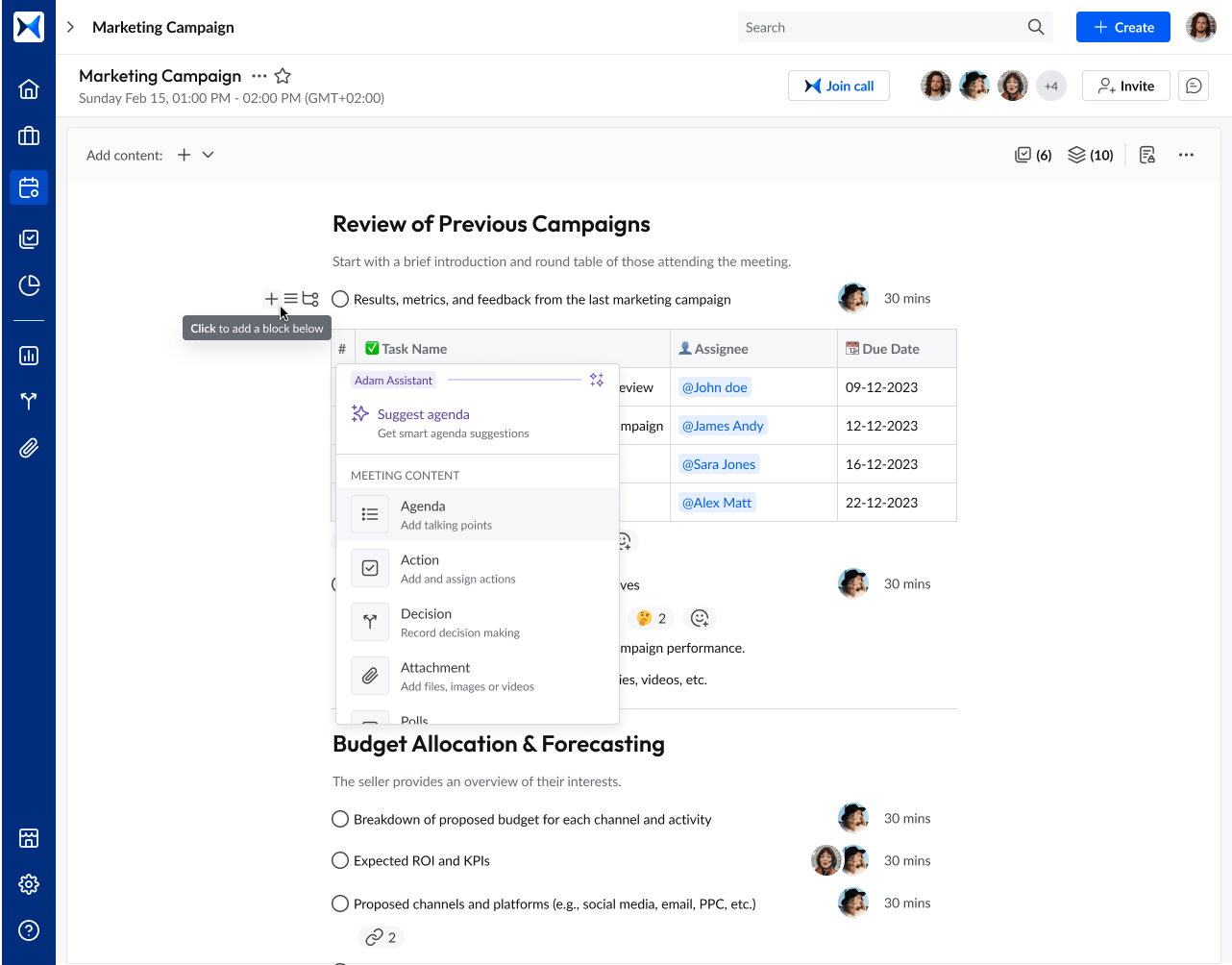
2. Content collaboration
Committees can collaborate seamlessly by attaching reports, sharing relevant documents, and tagging members during meetings. This feature centralizes all meeting content, reducing ambiguity and ensuring all stakeholders have access to the same information.
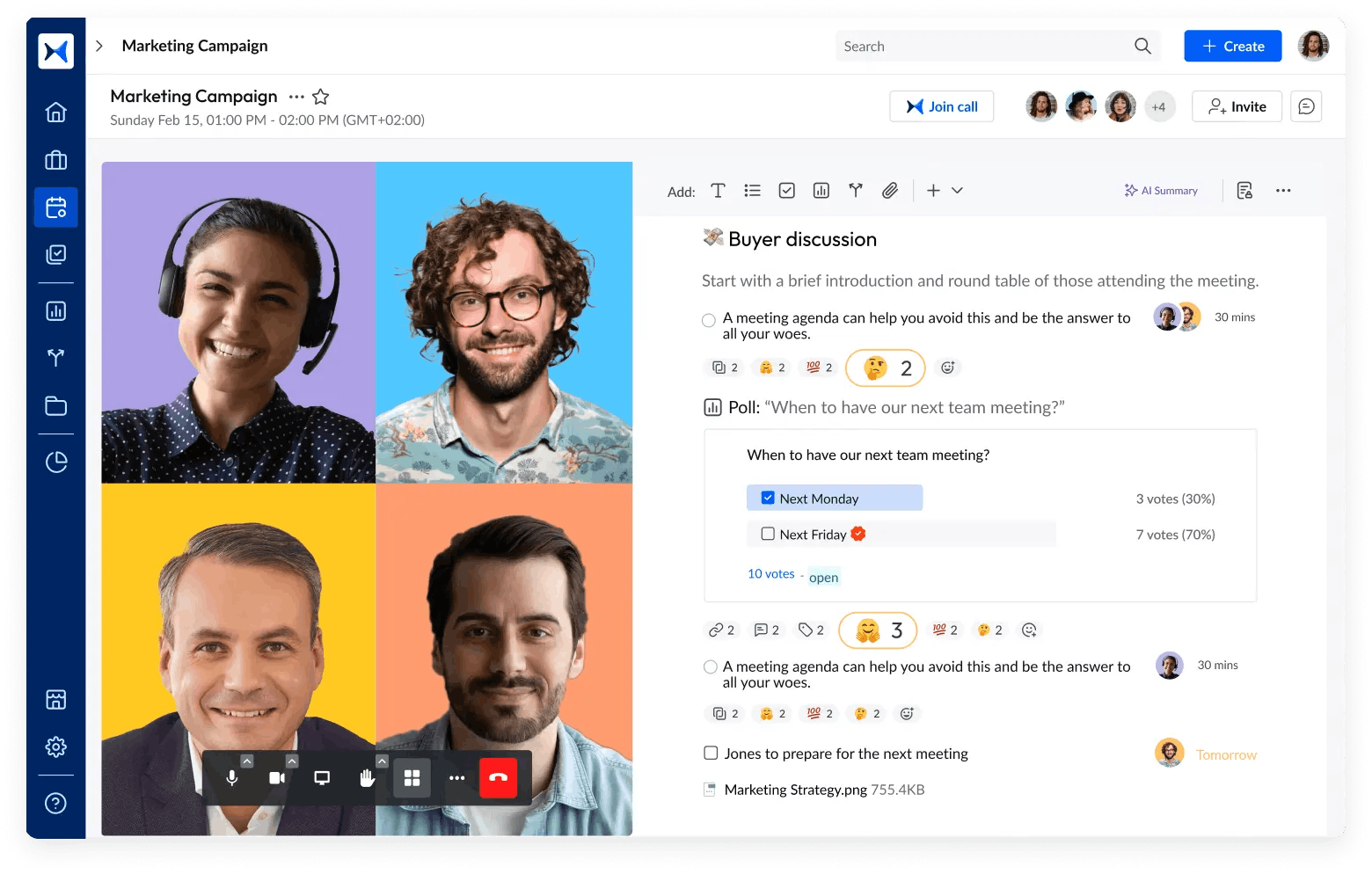
3. Action tracking
Tasks assigned during meetings are tracked with deadlines, owners, and related attachments. This makes it easy to monitor progress and provides a transparent record of accountability for follow-ups and task completion.
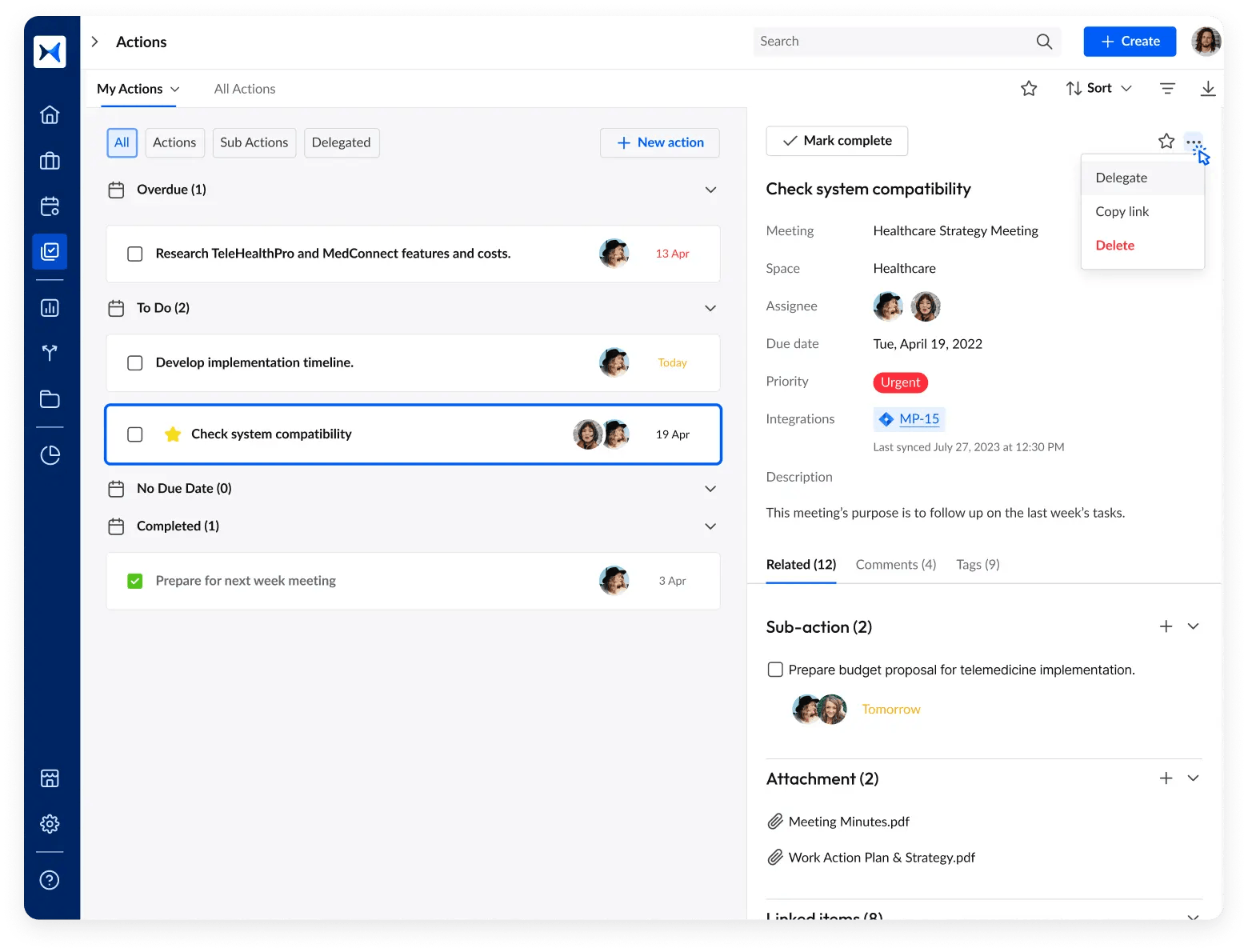
4. Polling for decisions
adam.ai’s polling feature enables committees to make collective decisions during meetings. By recording voting outcomes, it ensures transparency in how decisions are reached and agreed upon.
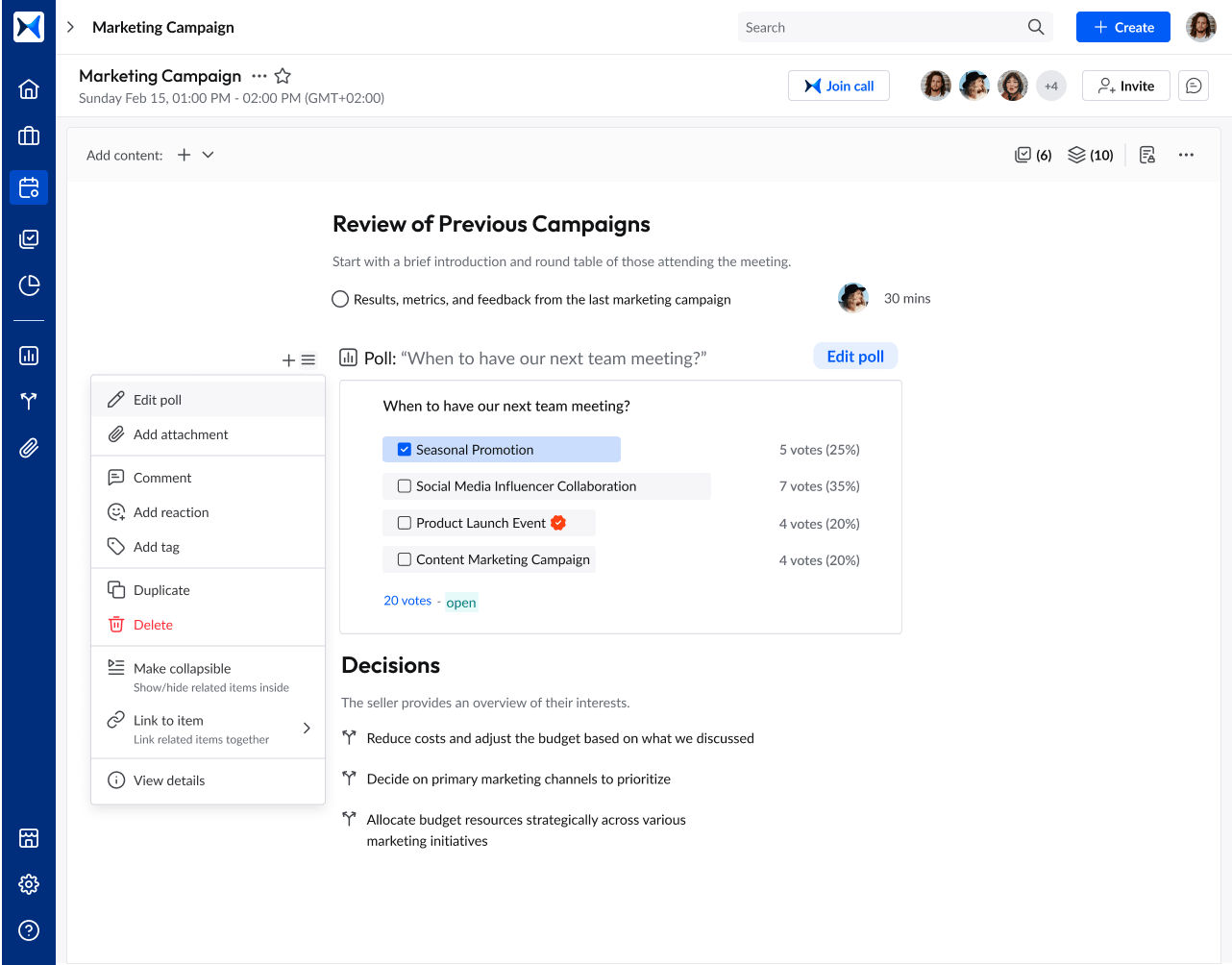
5. Meeting minutes
Automatically generated meeting minutes capture all discussions, decisions, and actions in detail. These minutes are stored centrally and can be accessed by stakeholders, ensuring transparency in all committee activities.
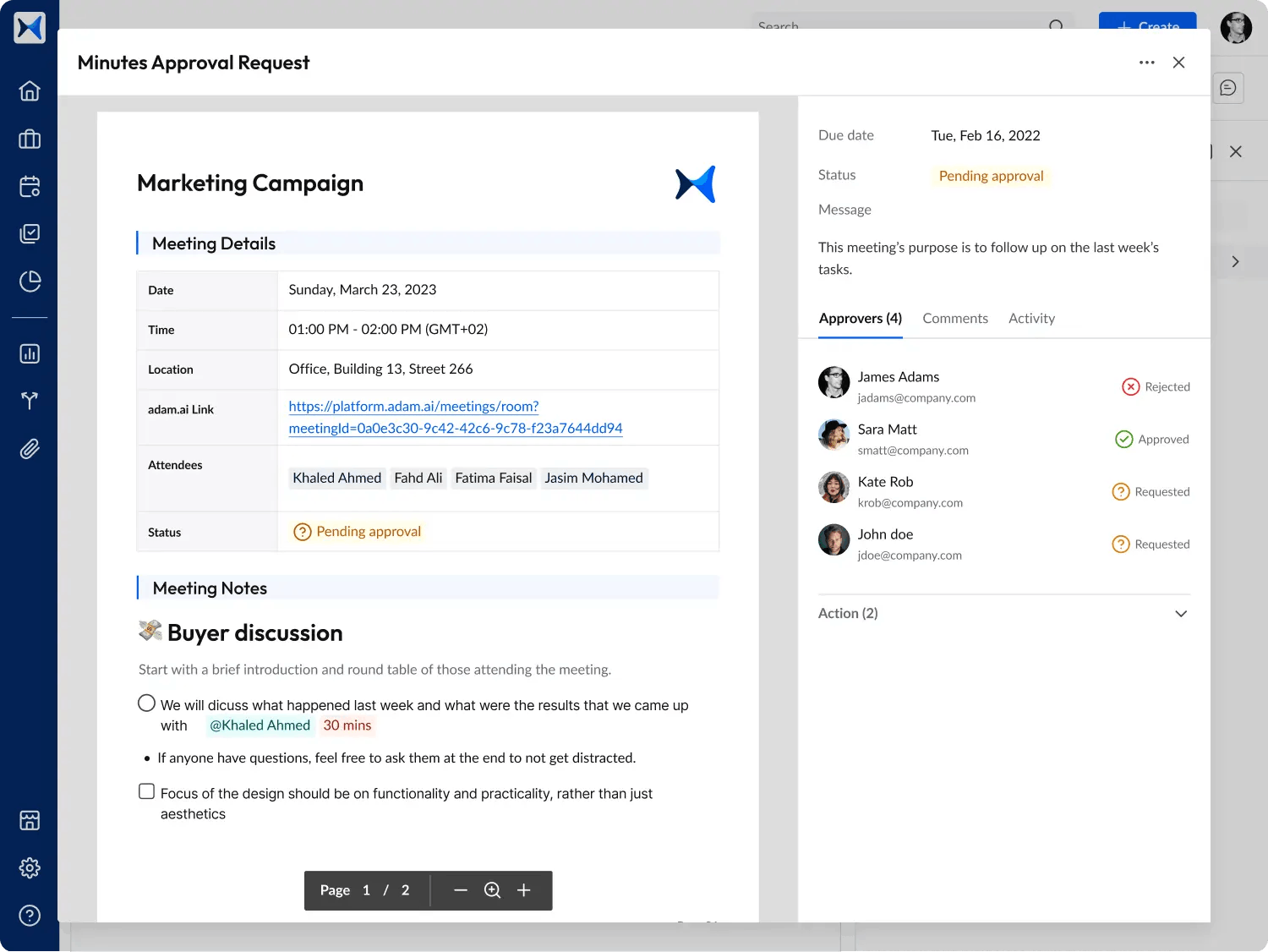
6. Analytical dashboards
adam.ai provides dashboards with metrics on meeting performance, attendance, and task completion. These analytics give committees insights into their efficiency and accountability, helping them identify areas for improvement.
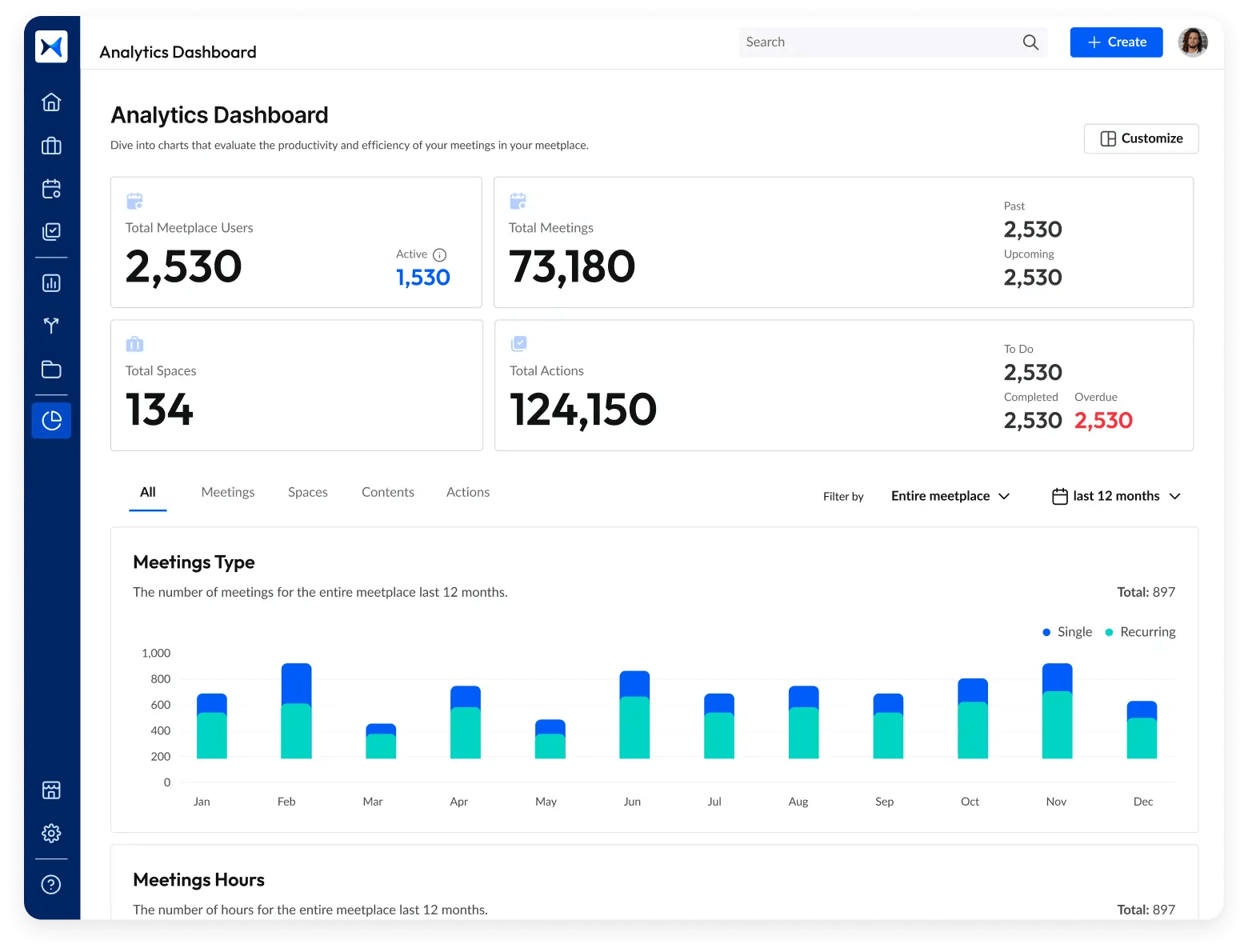
Transform how you conduct critical meetings—From meticulous preparation to effective execution and insightful follow-up, adam.ai integrates comprehensive analytics, full customization, and intuitive interfaces with powerful meeting management tools.
Easy onboarding. Enterprise-grade security. 24/7 dedicated support.
The bottom line
AI documentation is revolutionizing how government committees operate, making processes more transparent, efficient, and accountable. By embracing modern AI-driven tools, committees can foster trust, streamline operations, and set a new standard for governance.
And while there may be multiple solutions available, here is why adam.ai is the meeting management software platform you can trust:
- adam.ai is one of Atlassian Ventures' portfolio companies.
- In the meeting management software category on G2, adam.ai has been ranked a leader and a high performer for successive quarters in the past years.
- adam.ai has been included in the Forrester Report in the AI-enabled meeting technology landscape.
- adam.ai is trusted and used by powerful teams and organizations worldwide for all types of critical meetings, like board, committee, project management, and business development meetings.
- And most importantly, adam.ai integrates with your existing workflow, is SOC2 compliant, provides dedicated support and success, and has a free trial option.
Subscribe to adam.ai blog
Stay ahead with the latest insights—get our newest blog posts, tips, and updates sent straight to your inbox.